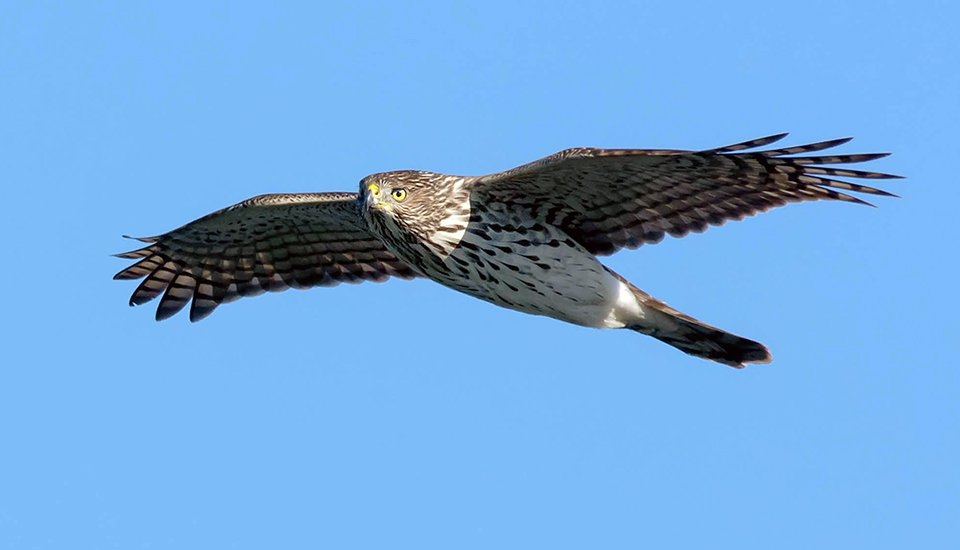For More Information
Cooper’s Hawk. Urban Raptor Conservancy.
Deal, E, Bettesworth, J, & Muller, M. 2017. Two records of female Cooper’s Hawks courting two different males in neighboring urban territories. Journal of Raptor Research, 51, 83-84.
Millsap, BA, Breen, TF, & Phillips, LM. 2013. Ecology of the Cooper’s Hawk in north Florida. North American Fauna, 78, 1-58.
Rosenfield, RN, et al. 2015. High frequency of extra-pair paternity in an urban population of Cooper’s Hawks, Journal of Field Ornithology, 86, 144-152.
Seattle Cooper’s Hawk Project: Annual Reports 2014-2018. Urban Raptor Conservancy.
Seattle Cooper’s Hawk Project

Juvenile Cooper’s Hawk in flight.
Paul Reeves Photography, Shutterstock.
Over the past 25 years, the Cooper’s Hawk has expanded much of its U.S. range from primarily undisturbed forests into many cities. The Seattle Cooper’s Hawk Project is one of several such studies in large cities (Tucson, Milwaukee, Albuquerque), and the only all-volunteer, citizen science project. The project began in
In his first season, Jack found only three nesting pairs. Jack began banding Coops, using blue visual identification (VID) bands, with the goals of documenting nest site fidelity, breeding adult turnover, nestling dispersal, longevity, and winter site fidelity. Jack and a team of volunteers monitored over 40 nesting territories through 2011, although not all were occupied every year.
By 2012, over 20 annual breeding pairs had been identified in the city. Jack turned his study over to Ed Deal and Martin Muller, who changed to new VID band colors (orange for females, purple for males) to distinguish “their” birds from Jack’s blue-banded birds.
Project Goals
The Seattle Cooper’s Hawk Project continues to:
- Monitor local population nesting density through annual censuses of the number of nests within Seattle’s city limits (84 square miles)
- Monitor the number of fledged young each year
- When possible, use VID (color-ID) bands to track fledgling dispersal, longevity, and fidelity of adult breeding and wintering sites
Results
Seattle’s carrying capacity for Cooper’s Hawks has still not been reached. Since 2012, the number of nesting pairs has increased each year, with high nest success rates, high fledgling productivity, little evidence of migration, strong site fidelity, and mostly short post-fledging dispersal distances.
- In 2012, 26 nesting attempts were documented, and 22 nests succeeded, producing 70 fledglings.
- By 2018 these numbers had nearly doubled to a record annual high of 46 nesting attempts, 40 successful nests, and 145 fledglings.
As of 2018:
- 84 historic or current nesting territories are known in the city.
- Nest productivity remains high, averaging 3.6 fledglings per successful nest (three nests fledged 5 young).
- Almost one-fourth (24%) of the breeding females are still in juvenile plumage, indicating an expanding population.
Sneaky Mates
Cooper’s Hawk pair at sunrise.
Martin Muller.
The abundance of urban Cooper’s Hawks allows many opportunities to observe their nuanced mating and nesting behavior. One such observation is that, even after pairs are observed building nests together, mated pairs continue to shop around.
Two reports from other populations support the possibility of infidelity in territorial pairs:
- A radiotracking study in Florida followed nesting pairs of Coops in adjacent territories. Before egg laying began, females from one territory trespassed on neighboring territories. This result suggested that the females were assessing the quality of the neighboring males and their territories.
- A large DNA study in Wisconsin showed that almost one-fifth of 140 offspring were “extra-pair” young (EPY). This result indicates that the fathers of these EPY were not from the nest territory.
In Seattle, Jack Bettesworth observed a banded (identified) female in 2011 who flew back and forth between two males during courtship. In 2015, Martin Muller and Ed Deal similarly spotted a banded female flying back and forth between the territories of two neighboring males. Jack documented 15 days in which “his” female commuted between the two males’ territories—and mated with each. She even mated with one male the day before she settled into incubation with the other male.